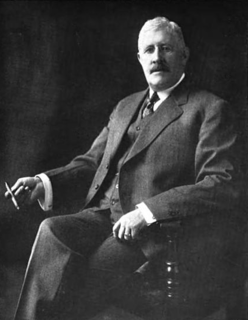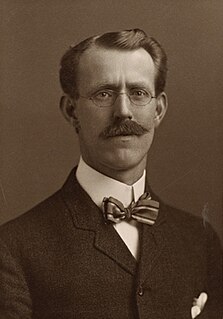
The dime novel is a form of late 19th-century and early 20th-century U.S. popular fiction issued in series of inexpensive paperbound editions. The term dime novel has been used as a catchall term for several different but related forms, referring to story papers, five- and ten-cent weeklies, "thick book" reprints, and sometimes early pulp magazines. The term was used as a title as late as 1940, in the short-lived pulp magazine Western Dime Novels. In the modern age, the term dime novel has been used to refer to quickly written, lurid potboilers, usually as a pejorative to describe a sensationalized but superficial literary work.

William Dickson Boyce was an American newspaper man, entrepreneur, magazine publisher, and explorer. He was the founder of the Boy Scouts of America (BSA) and the short-lived Lone Scouts of America (LSA). Born in Allegheny County, Pennsylvania, he acquired a love for the outdoors early in his life. After working as a schoolteacher and a coal miner, Boyce attended Wooster Academy in Ohio before moving to the Midwest and Canada. An astute businessman, Boyce successfully established several newspapers, such as The Commercial in Winnipeg, Manitoba and the Lisbon Clipper in Lisbon, North Dakota. With his first wife, Mary Jane Beacom, he moved to Chicago to pursue his entrepreneurial ambitions. There he established the Mutual Newspaper Publishing Company and the weekly Saturday Blade, which catered to a rural audience and was distributed by thousands of newspaper boys. With his novel employment of newsboys to boost newspaper sales, Boyce's namesake publishing company maintained a circulation of 500,000 copies per week by 1894. Boyce strongly supported worker rights, as demonstrated by his businesses' support of labor unions and his concern for his newsboys' well-being.

Edward L. Stratemeyer was an American publisher, writer of children's fiction, and founder of the Stratemeyer Syndicate. He was one of the most prolific writers in the world, producing in excess of 1,300 books himself, selling in excess of 500 million copies. He also created many well-known fictional book series for juveniles, including The Rover Boys, The Bobbsey Twins, Tom Swift, The Hardy Boys, and Nancy Drew series, many of which sold millions of copies and are still in publication today. On Stratemeyer's legacy, Fortune wrote: "As oil had its Rockefeller, literature had its Stratemeyer."

Penny dreadfuls were cheap popular serial literature produced during the nineteenth century in the United Kingdom. The pejorative term is roughly interchangeable with penny horrible, penny awful, and penny blood. The term typically referred to a story published in weekly parts of 8 to 16 pages, each costing one penny. The subject matter of these stories was typically sensational, focusing on the exploits of detectives, criminals, or supernatural entities. First published in the 1830s, penny dreadfuls featured characters such as Sweeney Todd, Dick Turpin, Varney the Vampire and Spring-heeled Jack.

The Star-Ledger is the largest circulated newspaper in the U.S. state of New Jersey and is based in Newark. It is a sister paper to The Jersey Journal of Jersey City, The Times of Trenton and the Staten Island Advance, all of which are owned by Advance Publications.
The Chicago Daily News was an afternoon daily newspaper in the midwestern United States, published between 1875 and 1978 in Chicago, Illinois.

Street & Smith or Street & Smith Publications, Inc. was a New York City publisher specializing in inexpensive paperbacks and magazines referred to as dime novels and pulp fiction. They also published comic books and sporting yearbooks. Among their many titles was the science fiction pulp magazine Astounding Stories, acquired from Clayton Magazines in 1933, and retained until 1961. Street & Smith was founded in 1855, and was bought out in 1959. The Street & Smith headquarters was at 79 Seventh Avenue in Manhattan; it was designed by Henry F. Kilburn.
Lone Scouts of America (LSA) was a Scouting organization for American boys that operated from 1915 until it merged with the Boy Scouts of America (BSA) in 1924. The LSA was founded by W. D. Boyce, publisher of the Chicago Ledger and the Saturday Blade and one of the founders of the BSA. Boyce felt that the program of the BSA did not help the rural boy who could not find enough other boys to form a troop or a patrol. James E. West, the first Chief Scout Executive of the BSA, disagreed with Boyce's concept, believing that the 4-H program was fulfilling the role. After Boyce left the BSA, he started the Lone Scouts of America and incorporated it on January 9, 1915. Boyce became the executive officer or Chief Totem and Frank Allan Morgan became the editor of The Lone Scout. In October 1915, Boyce appointed all of his paperboys as members of the LSA and published the first issue of The Lone Scout magazine.

African-American newspapers are news publications in the United States serving African-American communities. Samuel Cornish and John Brown Russwurm started the first African-American periodical called Freedom's Journal in 1827. During the antebellum South, other African-American newspapers sprang forth, such as The North Star founded in 1847 by Frederick Douglass.

The New York Ledger was a weekly story paper published in Manhattan, New York. It was established in 1855 by Robert E. Bonner, by transforming the weekly financial journal called The Merchant's Ledger that he had purchased in 1851. Bonner turned the paper over to three sons to operate in 1887.

Periodical literature is a category of serial publications that appear in a new edition on a regular schedule. The most familiar example is the magazine, typically published weekly, monthly, or quarterly. Other examples of periodicals are newsletters, academic journals and yearbooks. Newspapers, often published daily or weekly, are, strictly speaking, a separate category of serial. Periodicals are most often referenced by volume and issue. Periodicals have a set period and can be classified as popular and scholarly. Indefinite periodicals have an indefinite production cycle and have no plans to stop publishing. Periodicals use the International Standard Serial Numbers a standardized reference number. Periodicals often have a preferred and lower rate for postal distribution.
Charles Moore Magee was an American Professor of Literature and Languages and a collector of rare dime novels.
Golden Days for Boys and Girls was a late 19th-century children's story paper, distributed weekly as an accompaniment to the paper Saturday Night. Running from March 6, 1880, to May 11, 1907, Golden Days cost subscribers $3 a year. It was the brainchild of newspaperman James Elverson (1838–1911), who later owned the Philadelphia Inquirer.
William Wirt Sikes was an American journalist and writer, perhaps best known today for his writings on Welsh folklore and customs.
The Day Book was an experimental, advertising-free daily newspaper published in Chicago from 1911 to 1917. It was owned by E. W. Scripps as part of the Scripps-McRae League of Newspapers. Its editor was Negley D. Cochran, previously of The Toledo News-Bee. It was printed in tabloid size to save costs.

The Boyce Building is an historic building in Chicago, Illinois, associated with William D. Boyce and his publishing house, which catered to small towns. The building was also the headquarters of his Lone Scouts of America.
Frank Tousey (1853–1902) was among the top five publishers of dime novels in the late 1800s and early 1900s. Based in New York, his sensationalism drew a large audience of youth hungry for scenes of daring and tormented heroes and damsels in distress. Of particular notice in his approach to the 'blood and thunder' genre were the vivid cover illustrations of his dime novels, which were consistently larger and more thrilling than previous publications. Although focused on fictional weeklies, Tousey managed a variety of materials over time, including some handbooks, gossip sheets, and even a newspaper on current events in the Spanish–American War.

A. L. Burt was a New York-based book publishing house from 1883 until 1937. It was founded by Albert Levi Burt, a forty year old from Massachusetts who had come to recognize the demand for inexpensive reference works while working as a traveling salesman. The company began by reprinting home reference works and reprints of popular and classic fiction, before expanding into the field of children's works, particularly series books.
Albert Johannsen (1871–1962), was a geologist and geology professor at the University of Chicago who wrote several books on rocks. He also authored The House of Beadle and Adams and Its Dime and Nickel Novels (1950). He collected dime novels. His academic focus was petrology. He also wrote a book about Charles Dickens book illustrator Phiz.












